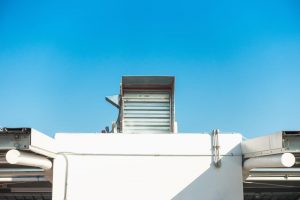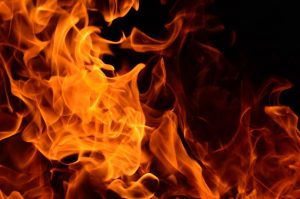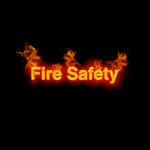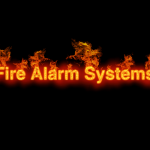Keeping your building’s fire dampers in perfect working order is essential when it comes to safeguarding the safety of all occupants in the event of a fire.
Failure to do so not only exposes the building and its occupants to serious fire safety risks but also amounts to non-compliance to the legal requirements set out in the Fire Safety Order.
Non-compliance puts you – the employer or building owner – at risk of paying hefty fines or even going to prison.
 A vital part of a building’s fire safety system, fire dampers are installed in specific points along the ventilation system to keep fire and smoke from spreading to other parts of the building, across fire barriers, through the ductwork in case of a fire.
A vital part of a building’s fire safety system, fire dampers are installed in specific points along the ventilation system to keep fire and smoke from spreading to other parts of the building, across fire barriers, through the ductwork in case of a fire.
As qualified and experienced professionals, we offer top-quality fire damper survey services. Our technicians have the necessary knowledge and expertise needed to locate, gain access, inspect, test and clean fire dampers in any building.
We will then put together a comprehensive and accurate report detailing the location of all of the fire dampers in your building, their condition, before and after inspection, cleaning and testing. We will also recommend replacements, repairs or improvements, if necessary.
Contents
What Are Fire Dampers?
Fire dampers are louvred shutters or vents installed within a building’s ductwork at specific points.
As essential fire safety measures, fire dampers, usually are dormant during normal operation of a building’s ventilation system; however, in case of a fire, they are designed to close shut, preventing fire and smoke from passing through and spreading to other parts of the building.
During a fire, the fusible links built into fire dampers melt when exposed to high temperatures, forcing the louvres to close shut.
The air vents and ductwork that is part of a building’s HVAC system plays a huge role in the mechanical circulation of air; helping maintain a comfortable and healthy indoor environment. However, in the event of a fire, the same life-saving ventilation system can prove to be dangerous by allowing smoke and flames to spread freely from one part of the building to the next, and so forth. The installation of functional fire dampers prevents this from happening.
In conjunction with fire doors and fire walls, fire dampers play an essential role in containing the spread of fire and smoke.
What Are Automatic Opening Vents (AOV)?
Automatic Opening Vents are designed to facilitate the normal day to day ventilation of buildings, as well as exhausting smoke in the event of a fire.
Some advanced AOV systems are designed with CO2, humidity, temperature sensors to create the most comfortable indoor environment. The opening of the AOVs is triggered by an alarm, allowing smoke to leave the building.
By exhausting smoke during a fire incident, AOVs make it easier for occupants of the building to escape, while also clearing the way for firefighters. In conjunction with the rest of the building’s fire safety system, including fire doors, fire walls and fire dampers, the AOVs play a considerable role in the containment of fires as well.
How Do You Test a Fire Damper?
 Fire dampers should be tested immediately after installation, and every two years afterwards, at the very least, according to the British Standard BS 9999 – the maintenance of ventilation ductwork is covered under this standard. Spring operated dampers should be tested annually. Any dampers used in extremely dusty conditions should also be tested more frequently.
Fire dampers should be tested immediately after installation, and every two years afterwards, at the very least, according to the British Standard BS 9999 – the maintenance of ventilation ductwork is covered under this standard. Spring operated dampers should be tested annually. Any dampers used in extremely dusty conditions should also be tested more frequently.
Fire dampers must be tested for reduced leakage, insulation and integrity to ensure that they remain in the best working order. During the test, the dampers must first be located, accessed and then numbered using test point labels. According to British standards, damper testing must be hands-on.
The technician conducting the test must visually inspect, clean, lubricate and also test each damper individually to ensure that they all work correctly. Once this is done, the technician will reset the dampers to ensure that they can work when called upon in future.
Finally, the technician will put together a comprehensive report that you can use to demonstrate or prove your compliance with fire safety guidelines and requirements.
In addition to documenting the location of each damper in the building, the report may also include information identifying any defective dampers that need to be replaced and other professional recommendations meant to help improve the effectiveness and efficiency of your building’s fire dampers.
What Is a Fire Damper Drop Test?
 As previously stated, fire dampers are equipped with a fusible link that is meant to release, closing the damper shut when exposed to high temperatures.
As previously stated, fire dampers are equipped with a fusible link that is meant to release, closing the damper shut when exposed to high temperatures.
To find out whether a damper is capable of successfully keeping fire and smoke from spreading through the air duct system a qualified technician must test the integrity of a damper’s closing mechanism and check to see whether the damper closes fully upon release.
Technicians perform what is referred to as a fire damper drop test. The test involves closing the damper through a manual release. Once the test is complete, the technician will then reset the damper.
Conclusion
Fire dampers are an essential part of your building’s fire safety system. Keeping them in the best working condition will not only safeguard your building and employees or occupants against fire risks but also ensures that you comply with the Fire Safety Order.
To ensure that you end up with an accurate fire damper survey report that you can rely upon and use as proof of compliance, be sure to contact us today for a free quote.




